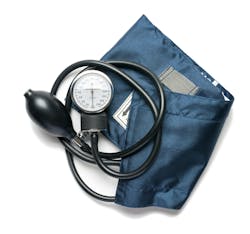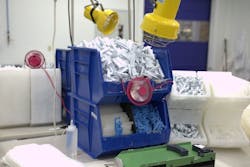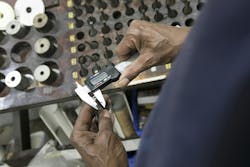Why Intentional Manufacturing Matters for Critical Medical Devices
When it comes to medical device design—a broad category that includes a range of different machines performing countless critical functions—the stakes are high. Because no matter the application, patient health and safety are on the line.
To those ends, medical engineers and designers are continuously performing due diligence to ensure devices function reliably under various conditions, minimizing potential risks to patients. Any quality lapses throughout any part of the product can lead to suboptimal outcomes and can potentially threaten patient safety.
Further, many medical devices, from surgical instruments to implantable appliances, require extreme precision—ensuring these devices meet tight tolerances, maintain their accuracy and function properly throughout their useful lives.
This is true for a variety of medical devices and machinery and the specific engineered components that go into them. It’s why for device designers, it is critical to work with manufacturing and outsourcing partners who can reliably meet your design specifications—whatever they may be.
In this article, we’ll discuss the important role of contract manufacturing partners for medical device production, the specifics of one real-life medical application and how medical device designers can work collaboratively with their component suppliers to meet strict design requirements and achieve consistent, reliable results.
The Role of the Contract Manufacturer for Medical Device Designers
Contract manufacturing plays a role in many forms of industrial production, where a company outsources a specific component or components and assembles them into the final product. Contract manufacturers typically offer niche expertise in specific areas that a manufacturer may not have in-house, and these important manufacturing partners can help medical device companies realize cost efficiencies, increase speed to market, and offer scalability and flexibility depending on need, among other benefits.
In medical device manufacturing, though, scrutiny of such partners must often be more thorough. It’s important for such a supplier to maintain medical standards in their processes and facilities (more on this later), be capable of manufacturing with suitable precision to meet medical specifications, and have access to materials science expertise for components that may be used in a medical application, particularly inside a human body.
Consider also end-use applications. Medical professionals need devices that are intuitive, easy to use and actively help reduce the potential for human error. Good design contributes to devices that fit seamlessly into medical workflows, improving efficiency and reducing risks during procedures—thus, the right components are essential.
Application Focus: Blood Pressure Cuff Tubing
To best understand the specific criteria that contract manufacturing partners must satisfy when producing reliable components, let’s investigate a specific application example.
One of the most common and widely used health metrics provides that example. Blood pressure is an important health indicator that provides insight into how well the human heart and blood vessels are functioning. Consequently, blood pressure monitors are among the most common tools seen inside doctors’ offices, hospitals and other medical facilities.
READ MORE: MD&M West 2025 Content Hub
Thermoplastic tubing that connects the monitor’s pump to the cuff is an important component here. The tube carries air from the pump to the cuff, inflating it to temporarily stop blood flow in the target artery. After inflation, air is gradually released through the tube, allowing blood to flow again while pressure measurements are taken. The tube then often sends pressure data to an internal sensor that calculates blood pressure readings.
To accomplish these tasks reliably and repeatedly, the tubing must deliver a series of specific qualities. Some of these include:
- Elasticity. Blood pressure monitor tubing should demonstrate a good ability to resume its normal shape after being stretched or compressed—a process that happens each time a reading is taken.
- Longevity. Blood pressure monitors perform a repetitive task over the course of their useful lives, and the tubing must remain functional over the long term. This is especially true in continuous use settings (if a patient is hospitalized), where ongoing readings are taken automatically throughout a patient’s stay.
- Texture and grip. The tubing should effectively grip connectors, contributing to reliable performance.
- Smoothness. Blood pressure tubing frequently comes into contact with human skin and should provide an unobtrusive and pleasant tactile experience. Further, tubing that eliminates die lines and seams for uninterrupted internal and outside surfaces can contribute to monitor accuracy.
- Radiation compatibility. In hospital settings, blood pressure monitors may come into contact with ionizing radiation associated with X-ray machines. This makes it important for the tubing to resist degradation as a result of radiation exposure.
For medical design engineers in this example, the contract manufacturing partner supplying tubing should meet these criteria with extreme levels of consistency. Collaboration is important here (and in all instances of medical-related contract manufacturing)—the supplier should engage in open two-way communication to understand the exact requirements of the application.
Ideally, this partner should provide specialized insight into the anticipated behavior of the componentry based on experience with the material (thermoplastic elastomer, for example). Additionally, rigorous quality assurance systems should be in place to check uniformity and ensure high quality for all tubing or other components, granting further peace of mind.
Additional Considerations for Medical Device and General Machine Design
Medical device manufacturers should consider a few essential requirements when outsourcing critical parts for medical devices. Some of them include:
ISO 13485 compliance. This is the medical industry’s device quality management system standard, which helps ensure all medical devices are manufactured with suitable quality controls. It is an important validation for component suppliers serving the medical industry. For example, a jack-of-all-trades extrusion house may make TPE tubing but likely does not maintain compliance with these important criteria.
TAA compliance. The Trade Agreements Act (TAA) is a federal law requiring products purchased by the U.S. government to be made in the United States or within a designated TAA-compliant country. For medical device manufacturers, this is an important designation for selling to U.S. government-operated facilities like hospitals overseen by the U.S. Department of Veterans Affairs.
READ MORE: Gear Up: March Briefs, Reviews, Standards, Product Updates & More
Intellectual property (IP) assurance. Outsourcing component design and production typically involves sharing proprietary designs, specifications and potentially sensitive IP with suppliers. For any machine or device designer, this can lead to concerns about unauthorized use or IP leaks, especially when suppliers serve multiple clients, including competitors.
Unauthorized IP use can erode your competitive advantage and result in product imitations in the market, not to mention increase the potential for lengthy and costly legal disputes. So, it’s important that a supplier is willing to sign strong contractual non-disclosure agreements (NDAs) and is willing to submit to regular IP audits.
Assembly services. Is the outsourcing partner able to perform additional assembly services for critical components? This kind of service can help streamline manufacturing processes and logistics, and get products to market quicker.
Contract manufacturers play an important role in the medical device design ecosystem and for the production of complex machinery and devices at large. For design engineers, sourcing high-quality componentry that is dependable is essential, and working with partners who make an effort to understand what’s needed and uphold high-quality standards can make all the difference.
About the Author

Brian Lipowski
Director, Quality, Regulatory and Technical (QRT) Services, Kent Elastomer Products
Brian Lipowski became director of quality, Quality, Regulatory and Technical (QRT) Services at Kent Elastomer Products in October 2022. He has a track record of proven leadership and works to build the credentials of KEP’s QRT team. Lipowski brings valuable experience from the automotive and medical markets and will continue to expand KEP’s service to clients reacting to regulatory changes that address validation, material requirements and specifications—all critical issues in heavily regulated industries.



